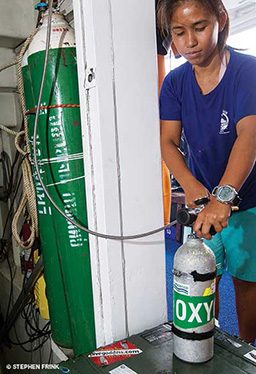Oxygen has long been recognized as the primary first aid for scuba diving injuries, specifically decompression sickness (DCS) and arterial gas embolism (AGE). Inhalation of 100 percent oxygen works by accelerating the diffusion and elimination of the excess nitrogen absorbed during diving, improving circulation (thereby promoting reoxygenation of tissues) and reducing swelling and associated inflammatory responses. For oxygen first aid to be most effective, the patient needs to breathe 100 percent oxygen delivered by a certified oxygen provider at an appropriate flow rate and with a good mask fit.
A Brief History of Oxygen Use in Diving First Aid
In 1878 French physiologist Paul Bert, while treating compressed-air divers and caisson workers, began using oxygen to relieve symptoms of what is now recognized as DCS. His experimental research on animals corroborated his clinical findings, which led him to be the first to propose using pressurized oxygen to treat “caisson disease.” Despite the fact that surface-pressure oxygen long remained the only available treatment for decompression, it was nearly a century before its use became widespread.
In the early 1960s the expansion of recreational scuba diving led to the use of hyperbaric oxygen to treat dive injuries. It was still another decade before oxygen was recommended while transporting an injured diver to medical care. The use of oxygen first aid for diving injuries increased over the years, but implementation was slow. A review of DAN dive accident data in 1987 revealed that only 37 percent of injured divers received oxygen first aid and that oxygen use in first aid actually dropped between 1987 and 1990. To promote oxygen use, DAN introduced the DAN Oxygen First Aid Program in 1991, which has evolved over the years as understanding of treatment and equipment has grown.
DAN’s Mission
In light of compelling evidence in favor of oxygen first aid, one of DAN’s stated missions is to ensure that oxygen first aid equipment and people trained in its use are at every dive site, which means dive instructors and even divers may need to own their own oxygen units, which they care for and maintain.
Storage and Maintenance of Oxygen Equipment
Oxygen units should be stored assembled but depressurized in protective cases. This ensures the equipment is ready to use and protects it not only from damage but also from exposure to oils and grease, which increases the risk of fire. To further reduce the fire hazard, the equipment should also be kept away from open flames or people smoking.
Oxygen units should not be exposed to temperatures higher than 125°F, so they should not be stored in motorized vehicles on hot days. When transporting units to and from dive sites, the equipment should be secured such that it will not fall or roll.
Note that oxygen cylinders are regulated by the same laws as scuba cylinders and thus should undergo hydrostatic testing every five years.
The standard procedure for oxygen-regulator maintenance involves service every two years or as the manufacturer recommends. The DAN website (DAN.org) provides a list of authorized service centers in the DAN America region.
Along with the regulator service, check the oxygen washer to ensure it is free of cracks, dirt, grease and oil. If any of these are present, change the washer. When reseating the regulator, confirm that the pins are aligned with the oxygen tank valve, and test for leaks by turning on the system. As always, remember to depressurize the system before storing it.
Service the oxygen-delivery mechanism (demand valve or manually triggered ventilator [MTV]) every two years or as recommended by the manufacturer. In addition, test MTVs and verify their function before each use. Test the demand valve by inhaling through the mask and exhaling away from it. Check the MTV by depressing the activation button then covering the ventilation outlet with the palm of your hand. It should automatically shut off. If it doesn’t, don’t use it, and send it in for servicing.
Visually check hoses and tubes for cracks or stress marks before each outing and when the system is serviced. Replace these as necessary.
Finally, inspect masks for cleanliness and signs of age.
After each use, clean the system using the following procedure:
- Wipe down the cylinder and hoses to remove sand or dirt.
- Disassemble the demand valve or MTV.
- Soak plastic parts in a mild bleach solution for 10 minutes, rinse with fresh water, and allow to air dry.
- Do the same with the oronasal mask (Pocket MaskTM), but discard the chimney.
- When all parts are dry, place a new chimney on the oronasal mask, reassemble the system, and store it in its protective case.
Nonrebreather masks and bag-valve masks are single-use items and should be discarded after use.
Filling Oxygen Cylinders

There are two primary methods of getting oxygen fills:
- with a prescription
- with documentation of training (must be current)
In 1996 the U.S. Food and Drug Administration (FDA) made allowances for obtaining oxygen for use in medical emergencies without a prescription. This ruling still requires consumers to present documentation of proper training before they purchase fills. The DAN Emergency Oxygen for Scuba Diving Injuries course helps divers meet those training requirements. Unfortunately, some states lack comparable rulings to that of the FDA, making access more challenging, while others such as Florida, Ohio and Rhode Island have enacted statutes specifically designed to improve divers’ access to oxygen.
Many divers obtain prescriptions from dive physicians or personal physicians who understand the need for emergency oxygen at dive sites; however, the prescription technically limits the administration of the prescribed drug (oxygen in this case) to the person for whom the prescription is written. Some doctors may be willing to write a prospective prescription authorizing dispensing emergency oxygen, although they are not obligated to comply with such a request.
© Alert Diver — Q3 Summer 2014